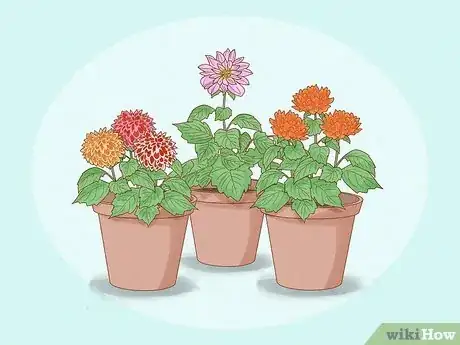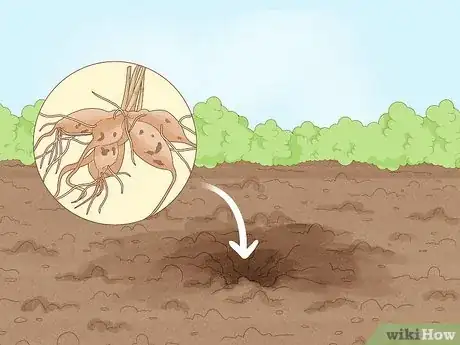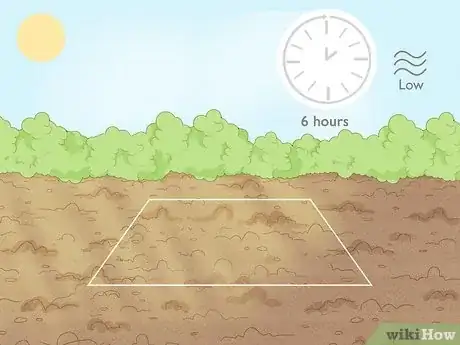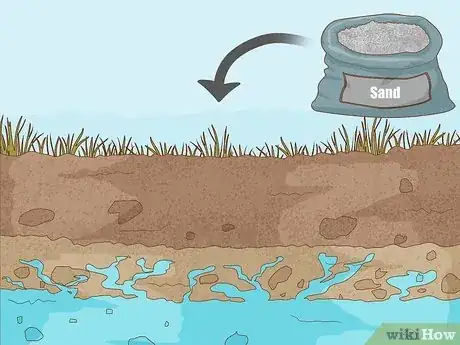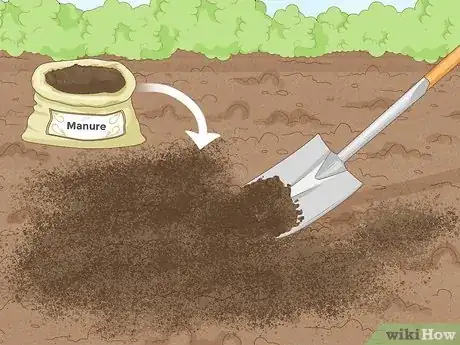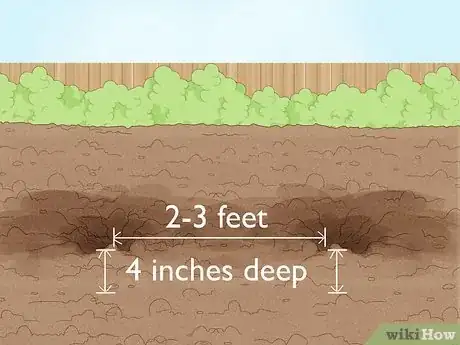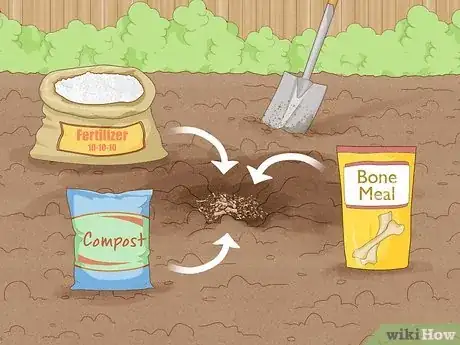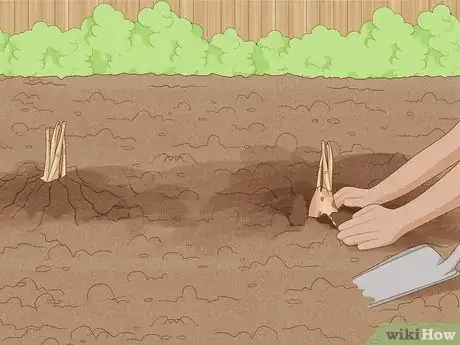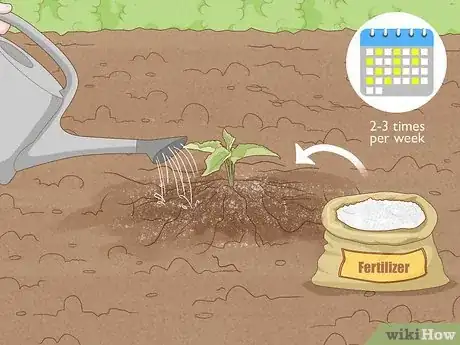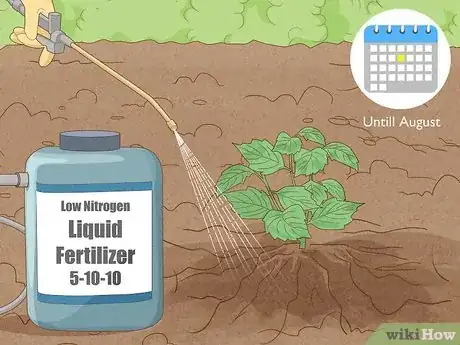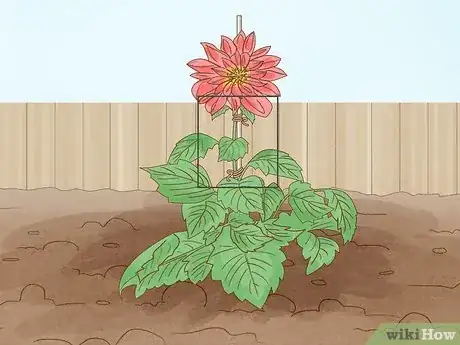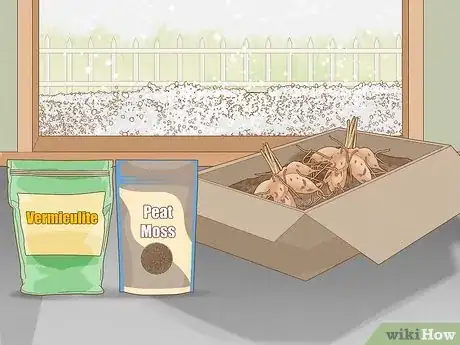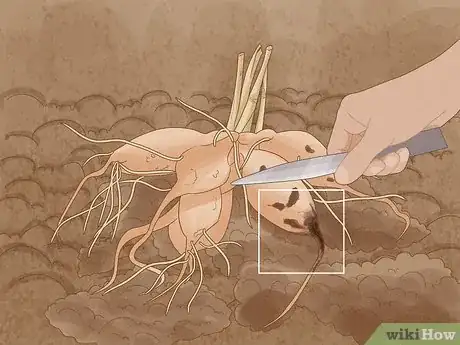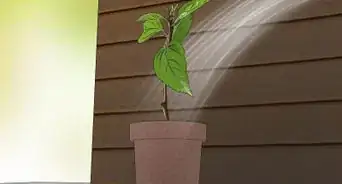This article was co-authored by Lauren Kurtz. Lauren Kurtz is a Naturalist and Horticultural Specialist. Lauren has worked for Aurora, Colorado managing the Water-Wise Garden at Aurora Municipal Center for the Water Conservation Department. She earned a BA in Environmental and Sustainability Studies from Western Michigan University in 2014.
This article has been viewed 42,647 times.
Dahlias are beautiful perennial plants and are relatively easy to grow. The plants produce attractive, large flowers in a variety of colors, and generally bloom late in summer or early fall. Most people grow dahlias from tubers, which are easy to purchase and plant, although they need to be fertilized before growing. Dahlias make a beautiful addition to a garden and are a popular choice for anyone considering landscaping their yard.
Steps
Selecting and Purchasing Dahlias
-
1Determine which of the dahlia varieties you would like to grow. Dahlia is a large plant family, and you’ll need to decide which size of plant will best suit your growing space. Unlike other popular flowers, dahlias come in three main categories: large (including the popular “Dinnerplate” variety), medium, and small. The size of both the blossoms and the overall plant will vary depending on which type you choose. Dahlia flowers also come in a wide array of colors, including white, yellow, orange, pink, purple, blue, red, or multi-colored.[1]
- Large dahlias can grow from 3–4 feet (1–1.2 meters) tall.
- Medium dahlias (also known as border dahlias) will reach between 1–2 feet (0.3–0.6 meters) in height.
- Small dahlias will only reach between 10–20 inches (25–50 cm) in height.
-
2Purchase fresh dahlia tubers. You should be able to find dahlia tubers for sale at any reputable plant nursery or garden center. Due to the variety and diversity among types of dahlias, be sure to ask the sales staff for assistance, or read the label on the package carefully. They’ll be able to help you determine which tubers will produce the size and color of blossoms you are looking for.
- If you live in a remote location and do not have access to a nearby plant nursery, you can purchase the dahlia tubers online instead. Check the websites for major online plant retailers including Eden Brothers, Dahlia Barn, Dahlias.com, or Harris Seeds.
Advertisement -
3Decide where to plant your dahlias based on your climate zone. Dahlias can be grown in many climates, but the tubers will need to be kept indoors during the winter in colder areas. Dahlias thrive in warm, sunny climates, and will survive the winter as tubers in zones 8 and 9.[2] If you live in the United States, this means that dahlias will not survive the winter if you live north of Kansas and east of western Idaho. If you live in zones 1–6, you will need to plant your dahlias in a greenhouse or at least store your dahlia tubers inside during the winter.
- Dahlias don’t do well in long, hot summers, so if you live in zone 10, you may need to cover outdoor dahlias or bring them indoors in summer.[3]
- If you live in zone 7, dahlias may be able to survive an outdoor winter if you insulate the soil over the tubers with a thick layer of dry mulch.
-
4Plant dahlias late in the spring. Wait to plant dahlias until your region no longer has a threat of frost. If you have a thermometer that can be used to measure ground temperature, that can guide your planting time. Do not plant the dahlias if the ground temperature is below 60°F (16°C), or the dahlias may not grow.[4]
- If you plant the dahlias too early (e.g. in March or April) and another frost comes, the tubers will die.
Planting Your Dahlias
-
1Select a location with full sun and low wind. Dahlias thrive in full sun, and should be planted in a location where they will be in direct sunlight for at least 6 to 8 hours a day. Dahlias also need to be protected from the wind, so plant them in a protected area. Their large flowers can become heavy when mature, and can snap off in a stiff breeze.[5]
-
2Plant your dahlias in well-drained, fertile soil. Soil that drains well will not form puddles, and will allow the tubers to absorb what liquid they need without drowning.[6] If you already have a garden or a section of your yard with well-drained soil, plant your dahlias there.
- If you’re concerned that the soil may not drain well, add sand to your soil to improve your garden’s drainage. Do this at the same time that you’re adding the compost or manure.
- If your soil is clay heavy, work peat moss or compost into the soil to loosen it. This can make it easier to plant dahlias.
-
3Add compost or manure to your soil. Use a spade to work manure or another fertilizer into your garden a couple of weeks prior to growing dahlias. It’s necessary to prepare your soil to grow dahlias before planting the tubers. Adding fully rotted compost or another fertilizer type to the soil will encourage the plants to grow well and bloom quickly.[7]
-
4Dig holes for the dahlias tubers. Each hole should be about 4 inches (10.16 cm) deep.[8] When digging the holes, leave enough space between the plants that growing dahlias will not choke one another or steal nutrients from one another.
- For smaller varieties, leave 2 feet (0.61 m) between holes. For medium or giant dahlias, leave 2 to 3 feet (0.61 to 0.91 m) between holes.[9]
-
5Fertilize the holes before planting the dahlias. Dahlias need plenty of fertilizer to grow successfully, and adding organic material to the soil ahead of time will help ensure that the plants grow well. Scoop a small handful of compost and bone meal into each of the holes, and add a small scoop of dry fertilizer.
- You can purchase ground bone meal at a local plant nursery or gardening center. If you do not already own compost and fertilizer, you can purchase them from a large gardening center or from a landscaping outlet.
-
6Plant dahlias in the prepared holes. Drop a single tuber in each hole, and then fill with soil. You can expect to see the tubers growing in 2 or 3 weeks.[10] Be sure the growing point of the tuber faces upward before you cover it with soil.
- Wait until you see new growth above the soil before you water the dahlias. It can take anywhere from several days to a couple of weeks for new growth to appear.[11]
Watering and Maintaining Dahlias
-
1Water and fertilize dahlias once sprouts show. Do not water the dahlia tubers before you can see growth, or you’ll likely drown the plant. Overwatering can also cause rot. Wait until you can see sprouts above the soil, and then water the dahlias only in the morning. This will prevent the water from evaporating if you live in a hot zone.[12]
- It’s not necessary to water the dahlias every day. Keep an eye on the plants and, when they begin to look a little wilted, water them generously. In general, it is best to water dahlias 2-3 times a week during the hottest part of the summer.
-
2Fertilize with a low-nitrogen liquid fertilizer. Fertilizers can help your dahlias grow quickly and well. They’ll thrive if given a low-nitrogen liquid fertilizer, which is the type most commonly used for vegetable gardens. You can fertilize the dahlias once they begin to sprout. Continue by fertilizing the plants about once each month until August.[13]
- You can purchase low-nitrogen liquid fertilizer at a local garden center or plant nursery. It may even be available at a supermarket. Look for a 5-10-10 or 10-20-20 mixture.
-
3Stake growing dahlias if you are using taller varieties. Tall dahlias may not be strong enough to support the weight of their own stems and flowers. Prevent these plants from falling over by tying them to stakes shortly after they begin to grow. You can use a thin piece of regular string or twine to fasten the stem to the stake.[14]
- You can use a plain wooden stake or dowel to secure the dahlias. If you’d rather have a more decorative garden, purchase a cylindrical tomato cage and let the dahlia use it as a support.
-
4Disbud the dahlias to produce a single, large bloom. Once a dahlia plant begins to develop several bunches of bushy leaves, pinch off all of the flower buds, except for the bud at the very top of the plant. This is known as the terminal bud and will produce a very large flower if the other buds are removed.[15]
- If you’re not concerned with producing large, impressive flowers (of the type that would be entered in a flower competition), you don’t need to disbud the plant. Simply let the buds grow where they will.
-
5Store your dahlia tubers indoors over the winter. If you live in a climate with cold winters (zones 1-6), dig up your dahlia tubers, cut individual tubers apart from the clump, and keep them in a cool, dry place over winter. Wait until the foliage turns black after the first frost in late fall or early winter, then cut the plant back to just 2-4 inches (5-10 cm) of growth above the ground. Dig up the tubers and let them dry out for a few days. Then place them in a ventilated box or basket filled with peat moss or vermiculite.[16]
- Store your tubers in an area where temperatures will remain between 45° and 55° F (7°-13° C).
-
6Examine your stored tubers for rot or dryness. Throughout the winter, check on your tubers from time to time. Rot may appear in the form of black spots or coatings of white or pink mold. Trim off any rotten spots. A dried out tuber can be refreshed with a light misting of water.[17]
Expert Q&A
-
QuestionHow do you overwinter dahlias?
 Lauren KurtzLauren Kurtz is a Naturalist and Horticultural Specialist. Lauren has worked for Aurora, Colorado managing the Water-Wise Garden at Aurora Municipal Center for the Water Conservation Department. She earned a BA in Environmental and Sustainability Studies from Western Michigan University in 2014.
Lauren KurtzLauren Kurtz is a Naturalist and Horticultural Specialist. Lauren has worked for Aurora, Colorado managing the Water-Wise Garden at Aurora Municipal Center for the Water Conservation Department. She earned a BA in Environmental and Sustainability Studies from Western Michigan University in 2014.
Professional Gardener In the fall before the first frost, but after the foliage has yellowed, remove the foliage and dig up the tubers. Let them dry out for several days before storing them. Place the tubers in a box with sawdust, peat moss, or newspaper. Keep them in a dark place with temps at about 40-45 degrees F.
In the fall before the first frost, but after the foliage has yellowed, remove the foliage and dig up the tubers. Let them dry out for several days before storing them. Place the tubers in a box with sawdust, peat moss, or newspaper. Keep them in a dark place with temps at about 40-45 degrees F. -
QuestionDo dahlias come back year after year?
 Lauren KurtzLauren Kurtz is a Naturalist and Horticultural Specialist. Lauren has worked for Aurora, Colorado managing the Water-Wise Garden at Aurora Municipal Center for the Water Conservation Department. She earned a BA in Environmental and Sustainability Studies from Western Michigan University in 2014.
Lauren KurtzLauren Kurtz is a Naturalist and Horticultural Specialist. Lauren has worked for Aurora, Colorado managing the Water-Wise Garden at Aurora Municipal Center for the Water Conservation Department. She earned a BA in Environmental and Sustainability Studies from Western Michigan University in 2014.
Professional Gardener Dahlias are hardy to USDA zone 8 and will regrow each year from the tubers. In climates that experience frost, the tubers must be removed from the ground in the fall and overwintered in a dark dry place.
Dahlias are hardy to USDA zone 8 and will regrow each year from the tubers. In climates that experience frost, the tubers must be removed from the ground in the fall and overwintered in a dark dry place. -
QuestionWhat is the minimum temperature for planting Dahlia tubers
 Community AnswerThe soil should be roughly 60 degrees. If you plant the dahlias in soil much cooler than this, they may not successfully grow.
Community AnswerThe soil should be roughly 60 degrees. If you plant the dahlias in soil much cooler than this, they may not successfully grow.
References
- ↑ http://www.gardeners.com/how-to/how-to-grow-dahlias/7125.html
- ↑ https://www.whiteflowerfarm.com/how-to-grow-dahlias
- ↑ http://www.southernliving.com/home-garden/gardens/planting-dahlias
- ↑ http://www.almanac.com/plant/dahlias
- ↑ http://www.americanmeadows.com/growing-dahlias
- ↑ http://www.southernliving.com/home-garden/gardens/planting-dahlias
- ↑ http://www.americanmeadows.com/growing-dahlias
- ↑ http://www.gardeners.com/how-to/how-to-grow-dahlias/7125.html
- ↑ http://www.almanac.com/plant/dahlias
- ↑ http://www.gardeners.com/how-to/how-to-grow-dahlias/7125.html
- ↑ https://www.almanac.com/plant/dahlias
- ↑ http://www.southernliving.com/home-garden/gardens/planting-dahlias
- ↑ http://www.almanac.com/plant/dahlias
- ↑ http://www.gardeners.com/how-to/how-to-grow-dahlias/7125.html
- ↑ http://www.americanmeadows.com/growing-dahlias
- ↑ http://www.gardeners.com/how-to/how-to-grow-dahlias/7125.html
- ↑ http://www.gardeners.com/how-to/how-to-grow-dahlias/7125.html
